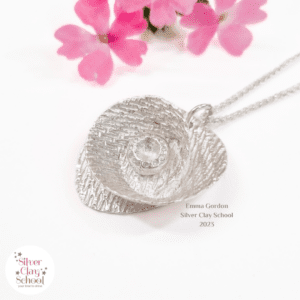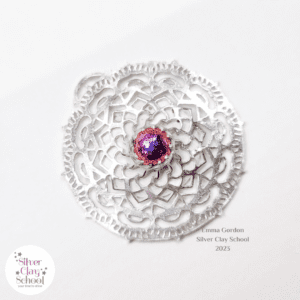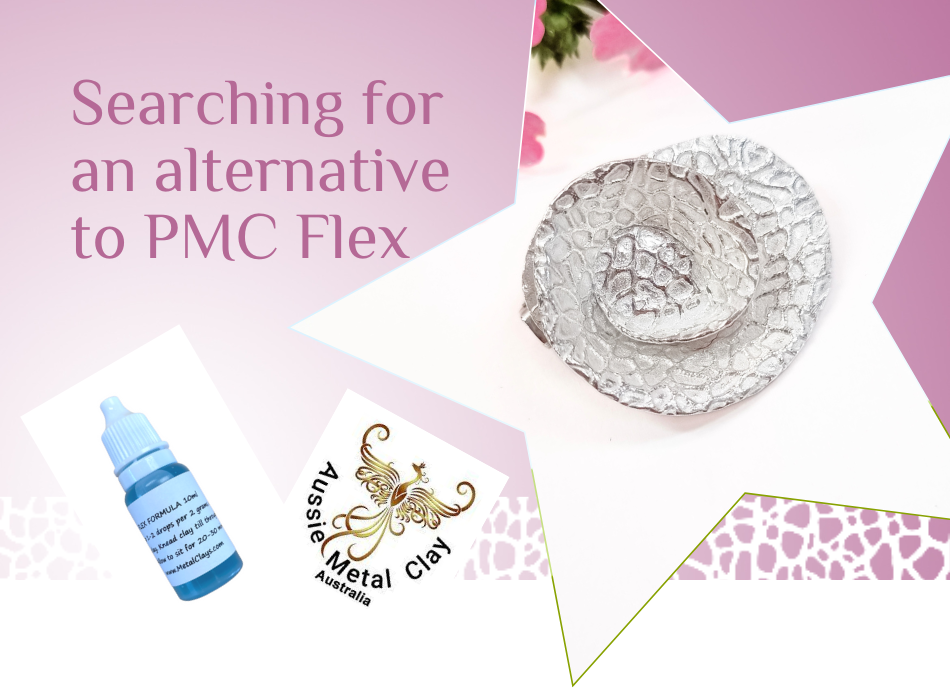Searching for an alternative to PMC Flex
We all know that PMC Flex is no more and I know that a lot of you are missing it. I know I am. I definitely know my students are too. On behalf of them and you too, I decided to go and see what else was out there. Here’s what I found in my search for a PMC Flex alternative.
What PMC Flex?
For those of you who don’t know, PMC Flex was a fine silver (999) clay) that was flexible when dry. It also boasted a longer working time than other clays, which meant that it stayed moist and workable longer outside of the packet. This made it ideal for the begin

Silver Clay School’s Rose Pendant Challenge
ner, new to clay because rolling and texturing clay can be tricky, especially in the beginning.
I used PMC Flex for specific things – my rose pendant project which involves a lot of twisting and manipulation of the clay once dried and my lace or net setting for glass cabochons. If you’re interested in either of these projects – I’ll pop some links at the bottom of this post.

Dichroic glass with silver clay lace setting
With this in mind, I was invested in trying to get something that worked well to ensure that my students who had bought either of these modules, could still do the projects despite not having PMC Flex. By the way – if you have purchased either or both of these modules, they will be updated with this new information.
I started to look around in the marketplace to see what was out there and chose two clays to test – both of which were fine silver (so I could fire them with glass and by torch*) and both said they were flexible after drying. *Please note that glass should never be fired by torch. I mentioned this only because my rose pendant is a beginner’s project and needs to be able to be hand fired.
These were Project X 999 Flex and Aussie Metal Clay (AMC) 999 Silver Flex.
I tried Project X 999 first. I had bought a packet of the 50g. I had also bought some 960 and was gifted some Sterling but I shall talk about my findings with them another day.
My experiences with these clays
Project X Flex 999 – this is a very new clay to the market, having only been released in the last few months. I intend to do a more in depth review of this clay in a later blog post, so I am only going to talk about how flexible this clay was. And unfortunately, although it is flexible after drying – far more so than Art Clay Silver and FYI, it was NOT flexible enough for either of my projects. If you’re looking for a tight swirl with the clay or something flexible to get out of a complex mould, then in my opinion, this is not the clay for the job.

Aussie Metal Clay 999 Flex
AMC 999 Silver Flex clay was, however, a different story I am happy to say and worked very well for both projects. I found it to be stickier than PMC Flex, which was a little awkward to work with, but it worked very well for both projects.
Flex Formula

Project X and Flex Formula
For those of you who don’t know, there’s a product called Flex Formula which is a liquid that you can add to your clays to make them much more flexible. This product is what I tried next. I added as per the instructions (1 drop for every gram of clay) and left in to be absorbed for 30 minutes before using. I have a YouTube video showing you how I added the formula and what my initial thoughts were. You can watch it here.

Art Clay Silver and Flex Formula
I added the Flex formula to the Project X Flex 999 and to Art Clay Silver 999 to see how it would work. I am happy to tell you that it worked really well with both clays and I successfully managed to create roses and set glass cabochons with the lace setting. Hurrah! Good news indeed.
Conclusions
I did enjoy using the Aussie Clay and if you want a one stop shop with no faffing about with any additions that this is the clay for you. It has a reasonable shrinkage rate, meaning you don’t have to worry about your glass setting splitting either (a consideration you have to have with Project X and its extremely high shrinkage rate). However, as much as I like Aussie clays – they are not the easiest to get hold of in a timely manner, especially in the UK. This is because they are a small business who don’t have the distribution power of the larger brands.
For me, the flex formula is going to be a staple in my studio from now on. As it can be added to any clay – it’s good to have on hand when you need your clay to be flexible for your projects.
I was delighted to see that Art Clay 999 silver morphed into a flexible clay that I could use with glass. This is one of the clays I use most often and I know it well.
It also helped Project X 999 achieve the flexibility that I specifically needed for my projects. But as I mentioned before – you have to be mindful of its shrinkage – somewhere between 25 and 28% which can be challenging when you want to fire glass in place. I was disappointed that this clay was not as flexible as I needed straight out the packet – but that said, it’s more flexible than normal clay (with the added flex Formula).
Links
Project X – UK
Project X – US
Flex Formula – UK
Flex Formula – US







Thank you for this. I have tried PROJECT X but was very disappointed..
Can you answer a question for me? If I decided to put a fired insect on a fired leaf after hallmarking with laser relief hallmark , will the hallmark be affected by the re firing?
It shouldn’t be Valerie, provided you’re firing properly and not too hot. The only reason the detail would be removed is if your piece started to melt.
Was there PMC Flex 5g? Thank you
Yes, there used to be. PMC is no longer manufactured.